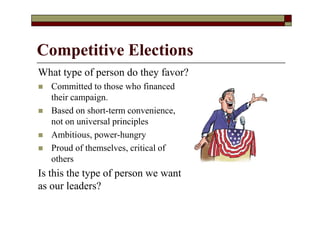Non adversarial elections
- 1. MUTUALISTIC, NON– ADVERSARIAL ELECTIONS Peter C. Newton-Evans November 2012 PUCE-Quito
- 2. Functions of a Group 1. To accomplish the tasks and objectives for which it was created 2. To create and strengthen unity among its members 3. To develop the potentialities of its members
- 3. Roles of Good Leaders ÔÅØ Establish the purpose for the consultation. ÔÅØ Emphasize the benefits of solutions that benefit all. ÔÅØ Assume the role of group coordinator. ÔÅØ Periodically summarize opinions, possibilities for consensus and move group toward an agreement. ÔÅØ Give credit to group members for decisions and achievements. ÔÅØ Involve everyone in the work to be done.
- 4. Traditional Leadership Style: Effects: ÔÅØ Authoritarian ÔÉ® Passive resistance ÔÅØ Paternalistic ÔÉ® Dependency on leader ÔÅØ Know-it-all ÔÉ® Inferiority, fear of errors ÔÅØ Manipulative ÔÉ® Mistrust, cynicism (incredulity)
- 5. The New Leadership  Servant Leadership: an attitude of service towards others.  Goal-oriented Leadership: transcends problem-oriented activity by following a vision.  People-Centered Leadership: developing abilities is at least as important as getting the job done.  Empowering Leadership: believes in and promotes the development of man’s inherent nobility.  Transformational Leadership: seeks psycho-cultural and socio-structural change.  Principle-centered Leadership: seeks to discover and apply the truth in all situations.  Moral Leadership: morality defined not only as not doing harm, but especially seeking the wellbeing of others.
- 6. Three Types of Democracy ÔÅØ A commitment to an electoral process (representative democracy) ÔÅØ The emphasis on consensus building (consent-based democracy) ÔÅØ Participation in implementing decisions (participatory democracy)
- 7. Is democracy the solution? ÔÅØ Divisive Party Politics ÔÅØ Promoting Vested Interests ÔÅØ Participationafter decision is made ÔÅØ Elections not truly free ÔÅØ Illogicof government versus opposition
- 8. Problems with Democracy ÔÅØ Electioneering leads to a lack of suitable candidates. ÔÅØ Narrowly focused on representative democracy and elections, ignoring the participatory dimension. ÔÅØ Pseudo-participation: leaders invite opinions, but continue to impose their ideas. ÔÅØ Decision-making based on partisan struggles, which does not lead to the common good. ÔÅØ Little emphasis on other capabilities needed for effective leadership.
- 9. Against Partisan Elections “The ideology of partisanship that has everywhere boldly assumed democracy’s name… today finds itself mired in the cynicism, apathy, and corruption to which it has given rise. In selecting those who are to take collective decisions on its behalf, society does not need and is not well served by the political theater of nominations, candidature, electioneering, and solicitation.” (Bahá’í International Community, “The Prosperity of Humankind”)
- 10. Competitive Elections What type of person do they favor? ÔÅÆ Committed to those who financed their campaign. ÔÅÆ Based on short-term convenience, not on universal principles ÔÅÆ Ambitious, power-hungry ÔÅÆ Proud of themselves, critical of others Is this the type of person we want as our leaders?
- 11. Let’s Discuss  What is the purpose of holding elections?  When people seek leadership roles, what strategies do they use to get elected?  As a result of this, what kinds of people tend to get elected?  Are these the most desirable characteristics in a leader? Why or why not?  If an election produces these results, has it fulfilled its purpose?
- 12. Conclusions  The adversarial electoral system produces a “social dilemma”: when everyone acts according to the logic of the system, it fails to fulfill its purpose, or collapses.  We need to change the rules of the game to replace it with a mutualistic or cooperative electoral system.  One such system is called “Candidate-Free Elections.” Let’s give it a try!
- 13. Electoral Method ÔÅØ Decide how many members to elect (#N) ÔÅØ Discuss their duties and the qualities they should have, without mentioning names ÔÅØ No candidates nominated: all are eligible ÔÅØ Secret election: no names mentioned before, during or after voting ÔÅØ Each voter writes N names on the ballot slip ÔÅØ Those with simple majority are the members ÔÅØ If there is a tie, vote again among those tied
- 14. Qualities we Seek ÔÅØ Solidarity with the common good ÔÅØ An open, inquisitive mind ÔÅØ Justice and integrity ÔÅØ A spirit of service ÔÅØ Recognized ability ÔÅØ Mature experience
- 15. Non-considerations ÔÅØ Gender ÔÅØ Religion ÔÅØ Social class ÔÅØ National origin ÔÅØ Racial or ethnic group ÔÅØ Other secondary matters
- 16. De-Briefing Having tried a “Candidate-free Election,”  What advantages does it have over the usual method?  How can we promote this approach in other groups we belong to?  Could that provide an opportunity to talk about what we have learned in this course?

















